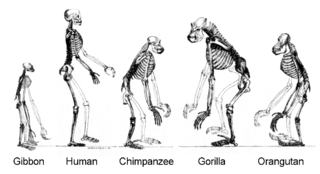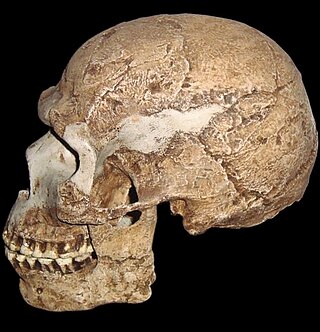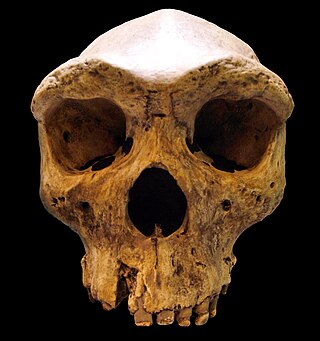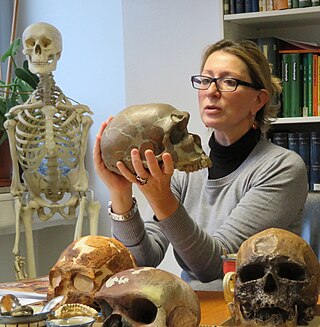Related Research Articles

Human evolution is the evolutionary process within the history of primates that led to the emergence of Homo sapiens as a distinct species of the hominid family that includes all the great apes. This process involved the gradual development of traits such as human bipedalism, dexterity, and complex language, as well as interbreeding with other hominins, indicating that human evolution was not linear but weblike. The study of the origins of humans involves several scientific disciplines, including physical and evolutionary anthropology, paleontology, and genetics; the field is also known by the terms anthropogeny, anthropogenesis, and anthropogony.

Ronald Linn Rivest is a cryptographer and computer scientist whose work has spanned the fields of algorithms and combinatorics, cryptography, machine learning, and election integrity. He is an Institute Professor at the Massachusetts Institute of Technology (MIT), and a member of MIT's Department of Electrical Engineering and Computer Science and its Computer Science and Artificial Intelligence Laboratory.

Early modern human (EMH), or anatomically modern human (AMH), are terms used to distinguish Homo sapiens that are anatomically consistent with the range of phenotypes seen in contemporary humans, from extinct archaic human species. This distinction is useful especially for times and regions where anatomically modern and archaic humans co-existed, for example, in Paleolithic Europe. Among the oldest known remains of Homo sapiens are those found at the Omo-Kibish I archaeological site in south-western Ethiopia, dating to about 233,000 to 196,000 years ago, the Florisbad site in South Africa, dating to about 259,000 years ago, and the Jebel Irhoud site in Morocco, dated about 315,000 years ago.

Homo is a genus of great ape that emerged from the genus Australopithecus and encompasses the extant species Homo sapiens and a number of extinct species classified as either ancestral or closely related to modern humans. These include Homo erectus and Homo neanderthalensis. The oldest member of the genus is Homo habilis, with records of just over 2 million years ago. Homo, together with the genus Paranthropus, is probably most closely related to the species Australopithecus africanus within Australopithecus. The closest living relatives of Homo are of the genus Pan, with the ancestors of Pan and Homo estimated to have diverged around 5.7-11 million years ago during the Late Miocene.

Alice and Bob are fictional characters commonly used as placeholders in discussions about cryptographic systems and protocols, and in other science and engineering literature where there are several participants in a thought experiment. The Alice and Bob characters were invented by Ron Rivest, Adi Shamir, and Leonard Adleman in their 1978 paper "A Method for Obtaining Digital Signatures and Public-key Cryptosystems". Subsequently, they have become common archetypes in many scientific and engineering fields, such as quantum cryptography, game theory and physics. As the use of Alice and Bob became more widespread, additional characters were added, sometimes each with a particular meaning. These characters do not have to refer to people; they refer to generic agents which might be different computers or even different programs running on a single computer.

Homo floresiensis( also known as "Flores Man" or "Hobbit" after the fictional species) is an extinct species of small archaic human that inhabited the island of Flores, Indonesia, until the arrival of modern humans about 50,000 years ago.

Homo rhodesiensis is the species name proposed by Arthur Smith Woodward (1921) to classify Kabwe 1, a Middle Stone Age fossil recovered from Broken Hill mine in Kabwe, Northern Rhodesia. In 2020, the skull was dated to 324,000 to 274,000 years ago. Other similar older specimens also exist.
The year 1978 in archaeology involved some significant events.

The timeline of human evolution outlines the major events in the evolutionary lineage of the modern human species, Homo sapiens, throughout the history of life, beginning some 4 billion years ago down to recent evolution within H. sapiens during and since the Last Glacial Period.
Human taxonomy is the classification of the human species within zoological taxonomy. The systematic genus, Homo, is designed to include both anatomically modern humans and extinct varieties of archaic humans. Current humans have been designated as subspecies Homo sapiens sapiens, differentiated, according to some, from the direct ancestor, Homo sapiens idaltu.

Archaic humans is a broad category denoting all species of the genus Homo that are not Homo sapiens. Among the earliest modern human remains are those from Jebel Irhoud in Morocco, Florisbad in South Africa (259 ka), and Omo-Kibish I in southern Ethiopia. Some examples of archaic humans include H. antecessor (1200–770 ka), H. bodoensis (1200–300 ka), H. heidelbergensis (600–200 ka), Neanderthals, H. rhodesiensis (300–125 ka) and Denisovans.

Jebel Irhoud or Adrar n Ighoud, is an archaeological site located just north of the locality known as Tlet Ighoud, approximately 50 km (30 mi) south-east of the city of Safi in Morocco. It is noted for the hominin fossils that have been found there since the discovery of the site in 1960. Originally thought to be Neanderthals, the specimens have since been assigned to Homo sapiens and, as reported in 2017, have been dated to roughly 300,000 years ago.
Pappalysin-1, also known as pregnancy-associated plasma protein A, and insulin-like growth factor binding protein-4 protease is a protein encoded by the PAPPA gene in humans. PAPPA is a secreted protease whose main substrate is insulin-like growth factor binding proteins. Pappalysin-1 is also used in screening tests for Down syndrome.

In paleoanthropology, the recent African origin of modern humans or the "Out of Africa" theory (OOA) is the most widely accepted model of the geographic origin and early migration of anatomically modern humans. It follows the early expansions of hominins out of Africa, accomplished by Homo erectus and then Homo neanderthalensis.

Engis 2 refers to part of an assemblage, discovered in 1829 by Dutch physician and naturalist Philippe-Charles Schmerling in the lower of the Schmerling Caves. The pieces that make up Engis 2 are a partially preserved calvaria (cranium) and associated fragments of an upper and a lower jaw, a maxillary bone and an upper incisor tooth of a two to three year old Neanderthal child. The Schmerling Caves are situated just north of the Belgian municipality Engis, whence the name of this group. In 1833 Schmerling described and publicized the find, which included animal bones and stone tools. Recognizing their old age, he associated them with the "Ethiopian Type" of the diluvial period. Although it was not recognized as such until 1936, the publication represents the first scientific description of a Neanderthal fossil.
Zhiren Cave is a karstic cave in the Mulan Mountains that overlooks the Hejiang River in Chongzuo, Guangxi, China. Zhiren Cave is an early Late Pleistocene site that has yielded the fossil remains of possibly anatomically modern humans with some mixed archaic human features.

Katerina Harvati is a Greek paleoanthropologist and expert in human evolution. She specializes in the broad application of 3-D geometric morphometric and virtual anthropology methods to paleoanthropology. Since 2009, she is full professor and director of Paleoanthropology at the University of Tübingen, Germany. From 2020 to 2023 she was Director of the Institute for Archaeological Sciences and since 2023 she is Director of the Senckenberg Centre for Human Evolution and Palaeoenvironment at the University of Tübingen.

Misliya Cave, also known as the "Brotzen Cave" after Fritz Brotzen, who first described it in 1927, is a collapsed cave at Mount Carmel, Israel, containing archaeological layers from the Lower Paleolithic and Middle Paleolithic periods. The site is significant in paleoanthropology for the discovery of what were from 2018 to 2019 considered to be the earliest known remains attributed to Homo sapiens outside Africa, dated to 185,000 years ago. Since the time of its discovery in 2011, Jebel Faya, in the United Arab Emirates, had been considered to be the oldest settlement of anatomically-modern humans outside Africa, with its deepest assemblage being dated to 125,000 years ago.
Apidima Cave is a complex of five caves four small caves located on the western shore of Mani Peninsula in Southern Greece. A systematic investigation of the cave has yielded Neanderthal and Homo sapiens fossils from the Palaeolithic era.
References
- ↑ Fountain, J. W.; Larson, S. M. (1978). "Saturn's ring and nearby faint satellites". Icarus . 36 (1): 92–106. Bibcode:1978Icar...36...92F. doi:10.1016/0019-1035(78)90076-3.
- ↑ Rivest, R.; Shamir, A.; Adleman, L. (1978). "A Method for Obtaining Digital Signatures and Public-Key Cryptosystems" (PDF). Communications of the ACM . 21 (2): 120–126. CiteSeerX 10.1.1.607.2677 . doi:10.1145/359340.359342. S2CID 2873616. Archived from the original (PDF) on 2007-01-27. Retrieved 2012-01-28.
- ↑ Byerlee, J. D. (1978). "Friction of rocks". Pure and Applied Geophysics. 116 (4–5): 615–626. Bibcode:1978PApGe.116..615B. doi:10.1007/BF00876528. S2CID 128666327.
- ↑ ISBN 0-333-24827-9.
- ↑ Harvati, Katerina; Röding, Carolin; Bosman, Abel M.; Karakostis, Fotios A.; Grün, Rainer; Stringer, Chris; Karkanas, Panagiotis; Thompson, Nicholas C.; Koutoulidis, Vassilis; Moulopoulos, Lia A.; Gorgoulis, Vassilis G.; Kouloukoussa, Mirsini (2019). "Apidima Cave fossils provide earliest evidence of Homo sapiens in Eurasia". Nature . 571 (7766): 500–504. doi:10.1038/s41586-019-1376-z. PMID 31292546. S2CID 195873640.
- ↑ "1978: First 'test tube baby' born". On This Day. BBC News. 1978-07-25. Archived from the original on 2007-12-21. Retrieved 2013-12-18.
- ↑ Hauschka, P. V.; Reid. M. L. (1978). "Timed appearance of a calcium-binding protein containing gamma-carboxyglutamic acid in developing chick bone". Developmental Biology . 65 (2): 426–34. doi:10.1016/0012-1606(78)90038-6. PMID 680371.
- ↑ "First Successful Laboratory Production of Human Insulin Announced". News Release. Genentech. 1978-09-06. Retrieved 2014-01-06.
- ↑ Tof, Ilanit (1994). "Recombinant DNA Technology in the Synthesis of Human Insulin". Little Tree. Retrieved 2014-01-06.
- ↑ Pitt, D.; Hopkins, I. (1978). "A syndrome of mental retardation, wide mouth and intermittent overbreathing". Australian Paediatric Journal. 14 (3): 182–184. doi:10.1111/jpc.1978.14.3.182. PMID 728011. S2CID 45629810.
- ↑ Bendet, Ia. A.; Morozov, S. M.; Skumin, V. A. (1980). "Psychological aspects of the rehabilitation of patients after the surgical treatment of heart defects" Психологические аспекты реабилитации больных после хирургического лечения пороков сердца [Psychological aspects of the rehabilitation of patients after the surgical treatment of heart defects]. Kardiologiia (in Russian). 20 (6): 45–51. PMID 7392405 . Retrieved 25 June 2024.
- ↑ "Skumin syndrome". wikidata.org. Archived from the original on 2012-04-26. Retrieved 30 January 2023.
- ↑ Clance, Pauline R.; Imes, Suzanne A. (1978). "The Impostor Phenomenon in High Achieving Women: Dynamics and Therapeutic Intervention" (PDF). Psychotherapy: Theory, Research & Practice. 15: 241–247. doi:10.1037/h0086006.